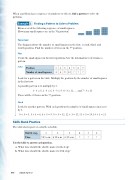Page 893 - Algebra 1
P. 893
When a problem has a sequence of numbers or objects, find a pattern to solve the problem.
Finding a Pattern to Solve a Problem
Brian created the following sequence of small squares. How many small squares are in the 7th position?
Understand
The diagram shows the number of small squares in the first, second, third, and fourth position. Find the number of boxes in the 7th position.
Plan
Count the small squares in the first 4 positions. Use the information to determine a pattern.
Solve
Look for a pattern in the table. Multiply the position by the number of small squares in the first row.
A possible pattern is to multiply by 3.
1 · 3 = 3, 2 · 3 = 6, 3 · 3 = 9, 4 · 3 = 12, ... and 7 · 3 = 21
There will be 21 boxes in the 7th position.
Check
Look for another pattern. With each position the number of small squares increases by 3.
0 + 3 = 3, 3 + 3 = 6, 6 + 3 = 9, 9 + 3 = 12, 12 + 3 = 15, 15 + 3 = 18, 18 + 3 = 21 Skills Bank Practice
The table shows part of a shuttle schedule.
Use the table to answer each question.
a. What time should the shuttle make its 6th stop? b. What time should the shuttle make its 10th stop?
Example
2
Position
1
2
3
4
5
6
7
Number of small squares
3
6
9
12
?
?
?
Shuttle stop
1
2
3
4
5
6
Time
5:45 a.m.
6:10 a.m.
6:35 a.m.
?
?
?
878 Saxon Algebra 1


